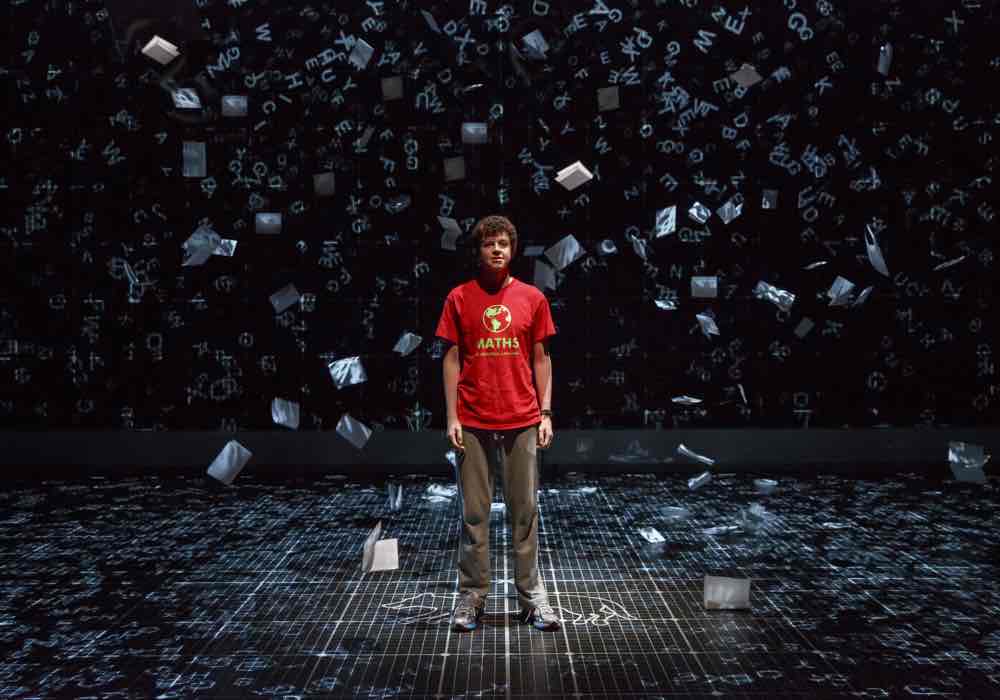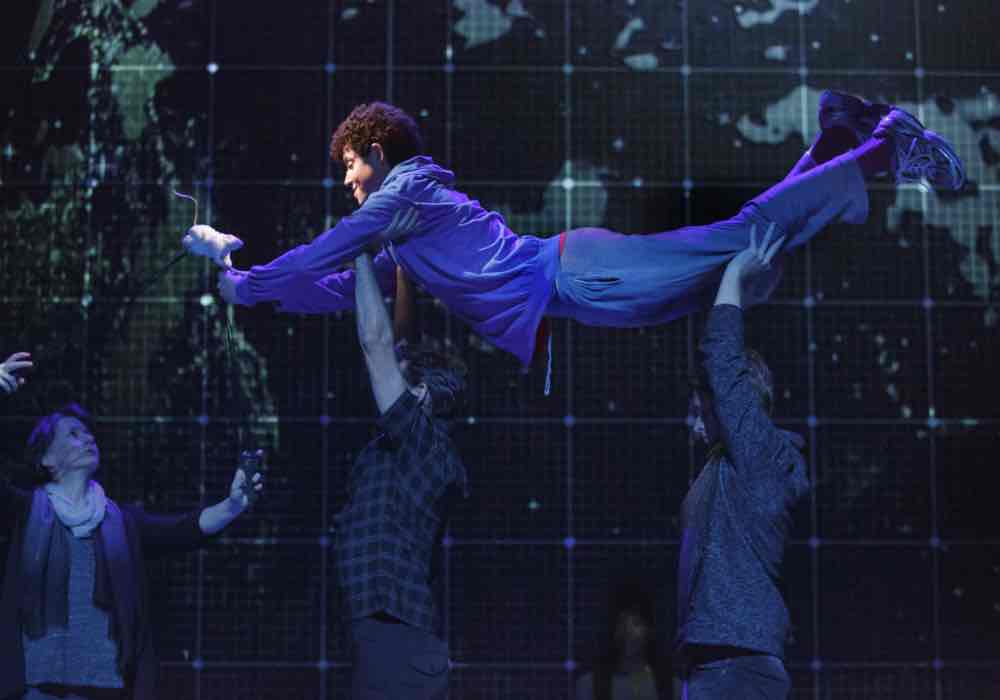Marianne Elliott’s The Curious Incident of the Dog in the Night-time takes us inside the mind of Christopher Boone, a sixteen-year-old with Asperger’s Syndrome who loves maths.

Adam Langdon as Christopher Boone in the touring production of The Curious Incident of the Dog in the Night-Time.
Marianne Elliott’s The Curious Incident of the Dog in the Night-time takes us inside the mind of Christopher Boone (Adam Langdon), a sixteen-year-old with Asperger’s Syndrome who loves maths. Based on the first person novel by Mark Haddon, and adapted for the stage by Simon Stephens, the production is a gorgeously choreographed and designed visual spectacle. Stephens has added framing devices to justify our immersion into Christopher’s perspective. The first few scenes of the play are narrated by Christopher’s teacher, who is reading from a book written by Christopher about his life. Soon enough, we discover that the play we are watching is actually an adaptation of the book, also by Christopher.
[clickToTweet tweet=”The Curious Incident of the Dog in the Night-time takes us inside the mind of Christopher Boone.” quote=”The Curious Incident of the Dog in the Night-time takes us inside the mind of Christopher Boone.”]
The inventive set design reflects Christopher’s interiority: what we’re seeing on stage is Christopher’s organized mental model of the place he lives and understands. In Christopher’s quiet hometown, where he lives with his father (Gene Gillette), everything is regimented. The stage is a seemingly empty black box, filled with large square tiles on the walls and the floor. The perimeter is covered in white boxes, which get moved around the stage as the only set elements. The edges and corners of the black tiles are equipped with LED lights that can be deployed to mark out specific areas on stage, like the perimeter of a room, or form a backdrop, like the outline of a house. Elliott can create the illusion of Christopher’s bedroom, a police station entrance, and the houses and gardens of Christopher’s neighbours, simply by lighting up a group of squares on the floor or walls to show us the floor plan.
[clickToTweet tweet=”‘The inventive set design reflects Christopher’s interiority.'” quote=”‘The inventive set design reflects Christopher’s interiority.'”]
We’re always aware of how active Christopher’s mind is, even though strangers are constantly calling him a moron. But it also serves to put a gloss of excitement over what, for Christopher, are very real challenges and not just a fun night out at the theatre. Making the production a thrilling visual spectacle too often takes us out Christopher’s perspective, asking to laugh at him rather than empathize with him.
[clickToTweet tweet=”‘Making the production a thrilling visual spectacle too often takes us out Christopher’s perspective'” quote=”‘Making the production a thrilling visual spectacle too often takes us out Christopher’s perspective'”]
Christopher’s limitations and challenges that result from Asperger’s are almost always played for laughs, which takes us out of his subjective perspective and asks us to judge him for something he can’t control. The script doesn’t point out the peculiarities of social custom, as seen from Christopher’s perspective, but treats his inability to conform with slapstick humour. There are many more jokes about the trouble Christopher gets into by taking everything literally than about the absurdity of other people’s insistence in speaking in nonsensical metaphors. Stephens doesn’t satirize a world full of easy prejudice, which is unwilling to engage with Christopher; instead, he implicates us in the cruelty, as if it’s part of the fun.

Gene Gillette as Ed and Adam Langdon as Christopher Boone in the touring production of The Curious Incident of the Dog in the Night-Time.
In an effort to add an emotional punch to the play, Stephens also gives us access to Christopher’s parents’ inner thoughts even though Christopher would not have had access to these himself. In a pair of monologues, Christopher’s father and mother lament their inability to connect to their son, both physically and emotionally. Elliott’s staging exacerbates our alienation from Christopher’s perspective by positioning each parent centre stage, facing the audience to deliver their speech, while an oblivious Christopher plays with his toys in profile. She deliberately puts us in the shoes of the parents because their experience is more likely to be one we can understand. But if Christopher can’t understand his parents’ expressions of love, how is he able to articulate their feelings in his play? If Christopher doesn’t have access to his parents’ innermost fears and feelings, neither should we.
[clickToTweet tweet=”‘If Christopher doesn’t have access to his parents’ innermost fears and feelings, neither should we.'” quote=”‘If Christopher doesn’t have access to his parents’ innermost fears and feelings, neither should we.'”]
Fortunately, things pick up in the second act, when Christopher makes the radical decision to leave home for London to find his mother. The train station and unfamiliar streets, each filled with people and noise, send Christopher into sensory overload. Elliott has the ensemble serve as the objects and locations Christopher encounters, from doors to ATM machines to labyrinthine streets. The way they constantly move about the stage, changing position and function, mirrors Christopher’s own confusion in his surroundings. He tries to make sense of them by mapping out his steps in an orderly way, and we can see the regimented path he charts through the tiles light up in red. The many signs Christopher has to decipher become a dance of words projected on the back wall of the stage, which move faster and faster, coming apart into alphabet soup before blurring altogether.
[clickToTweet tweet=”‘The way they move about the stage, changing position and function, mirrors Christopher’s confusion.'” quote=”The way they constantly move about the stage, changing position and function, mirrors Christopher’s own confusion in his surroundings.”]

Maria Elena Ramirez as Siobhan, Gene Gillette as Ed and Adam Langdon as Christopher Boone in the touring production of The Curious Incident of the Dog in the Night-Time.
Yet the inventiveness of Marianne Elliott’s production, designed to translate Christopher’s subjective experience of the ordinary world into something we can understand, backfires by changing the context too much. The technobeat music is a nice stand-in for the sheer amount of noise coming at Christopher — the bass line goes straight to your heart, disorienting and dizzying — by giving the audience a context of another kind of sensory overload that we might understand. But the script itself retains too much distance and an outsider perspective.
Christopher is less in awe, as we are, of the new stimuli he’s experiencing than merely trying to find his way through it. He’s just trying to get to his mother. He’s not trying to go on an odyssey. He doesn’t even understand the scrapes he almost gets himself into, like when he jumps onto the Tube tracks to chase after his escaped pet rat. It’s thrilling theatre, though. And that’s the problem: we get our kicks at the expense of someone who’s struggling, whom we’re only asked to understand at a surface level. If anything, the play’s sympathies lie with the people around Christopher who are afraid to tell him about his limitations.
[clickToTweet tweet=”How much of what we’re seeing on stage is really Christopher’s version of events?” quote=”How much of what we’re seeing on stage is really Christopher’s version of events?”]
The final line of the play is a question: Christopher asked his teacher if surviving a trip to London means he can do anything. She hesitates. He can survive more than she or we might have expected from him, but this simple task of life is difficult. On the other hand, he can pass his maths A levels with flying colours, without studying, after a stressful week, and live to tell the tale in an exciting play. Even still, we’re left wondering, how much of what we’re seeing on stage is really Christopher’s version of events, and how much has been filtered through his director to pander to us?

